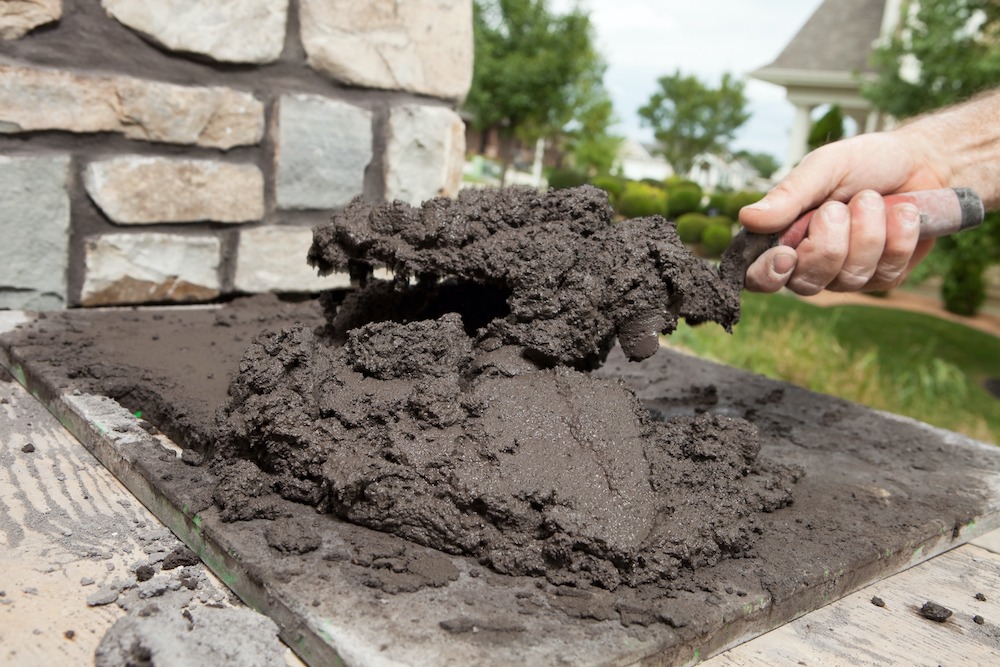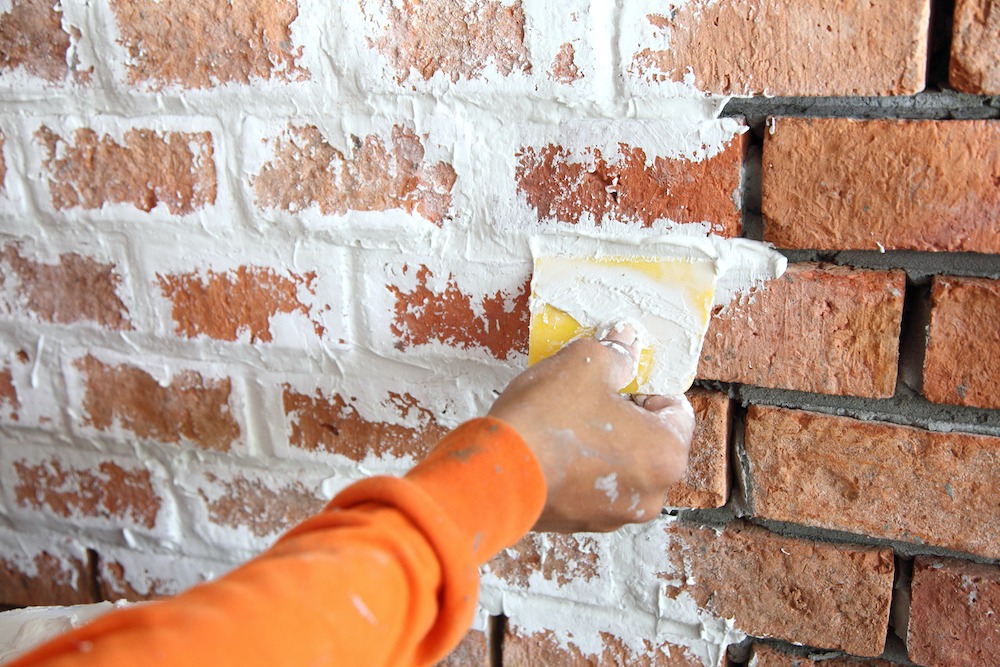The Influences on the Color of Mortar
Words: Dale Keller
Words: Dale Keller
Photos: Solomon Colors, BanksPhoto, Tawinaew
Using iron oxide pigments to color mortar has been in use for over 100 years. The ability of a small amount of pigment to change the color of several cubic feet of mortar is a testimony to the ingenuity of man.
The primary type of color pigment used to color mortar is iron oxides. Iron Oxide pigments can be mined and pulverized (natural) or processed from recycled scrap iron or nitrobenzene with metallic iron (synthetic). These processes produce pigments that meet ASTM-C979 the Standard for pigments to be used in Integrally Colored Concrete.
Color pigments are blended and tested to meet specific color standards as set by their manufacturer. The pigments are tested using the CIE-LAB system of color measurement. This system gives each color a specific numeric representation, that allows actual color differences to be related in numeric terms.
 A stone mason, holding a trowel, has picked up wet mortar in preparation for buttering a rock at a house construction site. Focus is on the board, the trowel is slightly soft with some motion blur. The worker is standing on a section of wood scaffolding.
http://www.banksphotos.com/LightboxBanners/Flooring.jpg
A stone mason, holding a trowel, has picked up wet mortar in preparation for buttering a rock at a house construction site. Focus is on the board, the trowel is slightly soft with some motion blur. The worker is standing on a section of wood scaffolding.
http://www.banksphotos.com/LightboxBanners/Flooring.jpg
This allows a manufacturer to ensure that each color blend they manufacture, matches all previous and future blends of that color. What does this mean for the designer and mason? The color pigments used on a project are the only product tested and certified for their color. Other products used in mortar are tested for their chemical properties and size, but not their color.
The way mortar is colored by the color pigment is not as straightforward as coating a surface with paint. Mortar is colored by mixing the color pigment with the entire mortar mix. The many times finer pigment particles surround and become part of the mortar matrix as the mortar hydrates. Pigments do not dye or change the color of the mortar material, instead, they disperse and surround the material in the mortar and become a part of the mortar, once thoroughly mixed. The color and characteristics of the materials that make up the mortar are important influences on the final color of the mortar.
The first component of the mortar that will primarily influence the color is the cementitious material that will be used. Masonry Cement or Portland Cement with Hydrated Lime are the two primary cementitious materials used in mortar. To achieve the mortar color you desire, the most critical element of the cement used is its color.
The color of cement varies widely depending on the color of the clinker limestone used to manufacture the cement. There is very light and very dark cement, and you need to realize that the color of the cement plays a big part in the final color of mortar once you have added the color pigment. To keep it simple, a dark cement can make a Light Buff mortar color look dirty and subdued. A light cement, by contrast, can make a Black mortar color look light and washed out. These results are not the result of a problem with the color pigment or the cement, they are just the reality of what those two materials when mixed look like. Try to use a cement that enhances and compliments the color you are trying to achieve.
Secondly, the sand used in the mortar is a major influence on the color. The sand is sieved to size to remove particles too large. But the color of the sand is determined by the source. Typically, every location has access to one or two sands to use in mortar. Know what your local sands are and what color they are.
Is the sand tan, is it light or dark, does it have odd colors, or is it uniform in color? Knowing your local sand options will help determine how the sands will influence the mortar color. Dark sand will make light colors look dirty, and light sands will make every color look a little washed out. Try to use the sand that best compliments the color you are trying to achieve.

The last component of mortar is water. You may be thinking how can a clear liquid affect color? Well, remember that cement is limestone that is pulverized and has the water molecule removed. When water is added to cement the process of hydration begins. As the cement re-hydrates, it uses the water to form a cement matrix with a crystalline structure. The more water available during the hydration process, the more crystalline structure. The more crystalline structure, the lighter the final color of the mortar. Conversely, less water will limit the crystalline structure of the cement and result in a darker color.
So, consistency is always the most important thing to remember about mixing mortar. Consistently use the same cement, sand, amount of water, and color pigment in each mix. Be consistent in how long the mortar is mixed, and even when the final strike of the mortar joint is made. Striking a joint that still is too wet, will bring water to the surface of the mortar joint, and result in final lighter color. Striking a joint that is too dry will result in a dark and rough surface.
After the masonry wall is constructed, an important last step that can influence the color of the mortar is how the wall is cleaned. A masonry wall is cleaned to remove any unwanted excess mortar or staining on the surface of the masonry units. Cleaning a masonry wall with too much chemical or with too much force can remove the surface of the mortar joint. Removing the surface of the mortar joint will reveal bare sand particles at the surface, changing the color that you see.
Sample panels are the only way to determine what a masonry wall will look like when using all the materials that will be used on the job. A sample panel lets you see how the color of the cement and sand complement the mortar color, or how they interfere with the mortar color. Then cleaning the panel allows you to see what the masonry wall should look like once the project is completed. The sample panel gives everyone a chance to evaluate and make decisions on what are the best choices in materials for the project.
There are several things that influence the final color of the mortar used in a masonry project. Being aware of the characteristics of the cement, sand, the effect of water and color pigment will help everyone to manage their expectations of what mortar color is achievable. Being consistent from batch to batch of mortar, and during masonry construction will help the mason to produce a masonry project with a mortar color that the designer and owner are expecting.